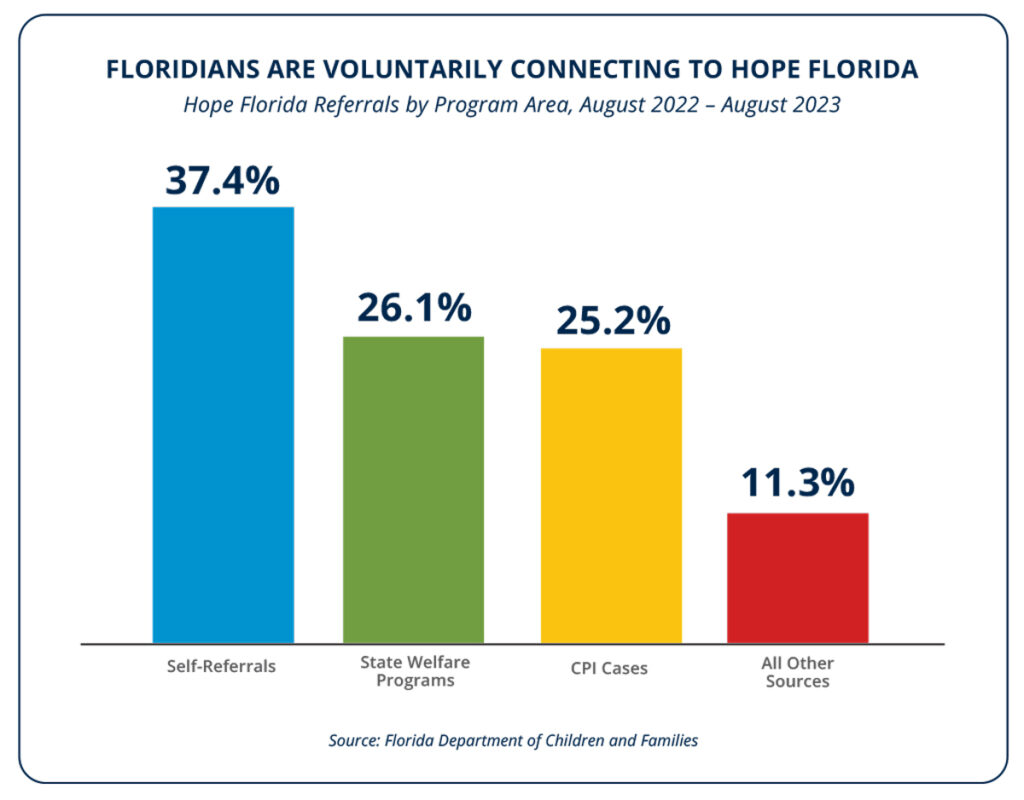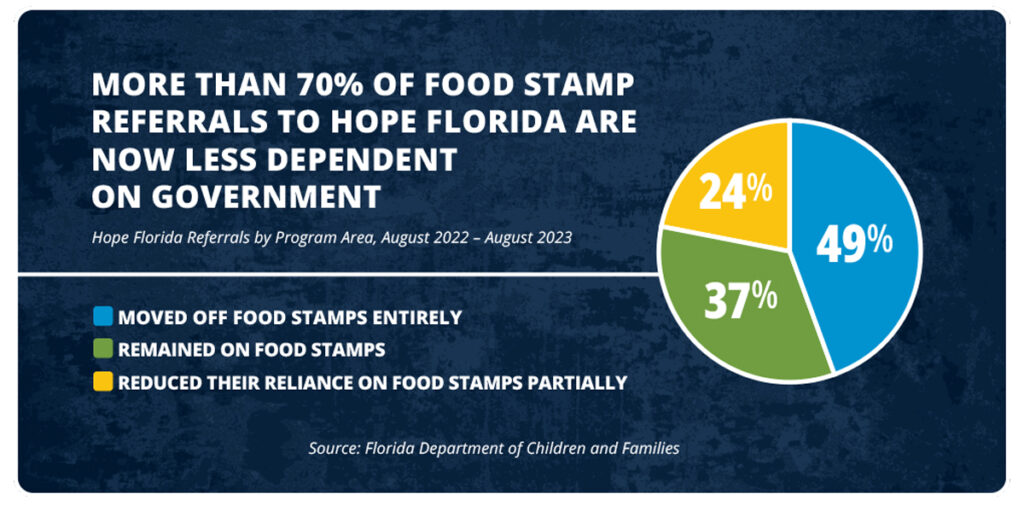How Hope Florida Is Putting Sunshine State Residents on a Path to Prosperity
Key Findings
- Hope Florida reaches countless Floridians from all walks of life.
- Food stamp enrollees are going back to work thanks to Hope Florida.
- Hope Florida is helping residents escape the trap of other welfare programs.
Overview
While millions of Americans across the country remain trapped on welfare, Florida has stood apart as a national leader in helping people escape the cycle of dependency. In 2016, then-Governor Rick Scott reinstated the work requirement for able-bodied adults without dependents (ABAWDs) on food stamps, empowering Floridians to find high-paying jobs in more than 1,000 different industries.1Under Governor Ron DeSantis, Florida has continued to assign ABAWDs and other able-bodied adults to Employment and Training (E&T) programs throughout the state, helping them move from welfare to work.2

However, even with work requirements in place, many still struggle on the path to self-sufficiency. For example, more than 60 percent of able-bodied adults aged 18 to 59 without young children who receive food stamps in Florida do not work at all.3 Additionally, outside of able-bodied adults, many vulnerable groups—such as former foster children, individuals with substance use disorders, and more—face barriers to employment.
Fortunately, under the leadership of Governor DeSantis, Florida has taken its efforts to reconnect individuals with meaningful work to the next level. Through the “Hope Florida – A Pathway to Prosperity” initiative, countless Floridians have been able to pursue their American Dream.
Hope Florida reaches countless Floridians from all walks of life
In September 2021, Florida First Lady Casey DeSantis launched the Hope Florida program, building on a successful pilot in six counties that assisted more than 10,000 residents through the Florida Department of Children and Families (DCF).4
Hope Florida uses “care navigators” to guide participating Floridians on their own personal journey by breaking down silos and connecting them with employers, non-governmental entities, faith-based and community organizations, and other resources.5

While the program was originally designed for children aging out of foster care, pregnant mothers battling substance use disorders, and similar families in need of assistance, the program has been expanded several times. In March 2023, Hope Florida was broadened to help at-risk youth who have been habitually truant, have run away from home, or have formed negative relationships.6 At the program’s second anniversary in September 2023, it was further expanded to help Floridians with unique abilities to find employment and community supports.7 Additionally, the program supports individuals on welfare statewide.8
Today, Hope Florida connects participants with business partners for employment opportunities, offers mentorship programs for troubled youth, provides support for those struggling with substance use disorders, and much more.9
In just two years, more than 70,000 Floridians were referred to the program.10 While the majority of these referrals came through the state’s welfare programs, for the last year, calls made by individuals of their own volition through the Hope Line were the largest source of referrals into the program.11 This is a testament to the program’s growing popularity—not only are state agencies and community partners connecting Floridians with the program, but individuals are reaching out to the program of their own accord.

As a result of these referrals, tens of thousands of Floridians have received help from the Hope Florida program.
Food stamp enrollees are going back to work thanks to Hope Florida
Since Hope Florida’s inception, nearly 40,000 Floridians on food stamps have been referred to the program.12
Importantly, in the first two years alone, more than 70 percent of individuals on food stamps who were referred to the program have moved off food stamps entirely or are relying on welfare less than they were before.13 This includes nearly 2,500 ABAWD referrals, more than 85 percent of whom have moved off food stamps entirely or partially.14 These results remain robust even when including a control group over the same time periods.

In August 2023 alone, the taxpayer savings from Floridians leaving or reducing their reliance on food stamps reached nearly $6.4 million.15 Annualized, this amounts to more than $75 million per year in taxpayer savings.16 In reality, the true figure may be even larger due to the avoidance of certain administrative costs associated with maintaining individuals on food stamps.
Hope Florida is helping residents escape the trap of other welfare programs
Since September 2021, nearly 4,000 cash welfare enrollees were referred to Hope Florida, more than 65 percent of whom have moved off cash welfare or are relying on cash benefits less than they were before.17
Additionally, there are undoubtedly positive spillovers into the Medicaid program as well. While savings and referrals are difficult to precisely quantify due to the pause in Medicaid redeterminations during the federal public health emergency and the subsequent resumption of renewals, preliminary data suggests that thousands of Medicaid enrollees in Florida have been connected to Hope Florida and have moved off government dependency.18
From food stamps to cash welfare to Medicaid, Floridians from different backgrounds have been connected with employers and other community supports through the Hope Florida program.

Bottom Line: Hope Florida is working, and policymakers can expand Employment & Training to supercharge it.
Hope Florida is working, empowering Floridians from all walks of life to better themselves, connect with mentors, receive treatment for substance use issues, escape welfare, and pursue self-sufficiency. It is a model silo-breaking initiative that has had a positive impact, reaching Floridians from Panama City to Palm Beach.
To amplify the positive results of Hope Florida, the state can further expand mandatory participation in its Employment and Training (E&T) program for food stamps to include all able-bodied adults aged 18 to 64 without young children. Since Hope Florida is a part of the state’s E&T program, making the program mandatory for more able-bodied adults will help them transition from dependency to self-sufficiency.
Hope Florida has been a tremendous success—and policymakers can supercharge the program’s impressive results with mandatory E&T.

References
- Jonathan Ingram and Nicholas Horton, “Commonsense welfare reform has transformed Floridians’ lives,” Foundation for Government Accountability (2019), https://thefga.org/research/commonsense-welfare-reform-has-transformed-floridians-lives/.
- Author’s analysis of Florida’s FY2023 Employment and Training state plan.
- Author’s analysis of the work status of able-bodied adults aged 18 to 59 without children under six on food stamps in Florida from the FY2020 QC pre-pandemic period. See, e.g., Mathematica, “Supplemental Nutrition Assistance Program (SNAP) quality control data,” Mathematica (2020), https://snapqcdata.net/.
- Office of the Governor, “First Lady Casey DeSantis announces major new initiative,” State of Florida (2021), https://www.flgov.com/2021/09/09/first-lady-casey-desantis-announces-major-new-initiative/.
- Ibid.
- Office of the Governor, “First Lady Casey DeSantis announces Hope Florida—A pathway to potential, expanding the Hope Florida model to support at-risk youth and their families,” State of Florida (2023), https://www.flgov.com/2023/03/29/first-lady-casey-desantis-announces-hope-florida-a-pathway-to-potential-expanding-the-hope-florida-model-to-support-at-risk-youth-and-their-families/.
- Office of the Governor, “Celebrating two year anniversary of Hope Florida, First Lady Casey DeSantis announces initiative expansions,” State of Florida (2023), https://www.flgov.com/2023/09/05/celebrating-two-year-anniversary-of-hope-florida-first-lady-casey-desantis-announces-initiative-expansions/.
- Florida Department of Children and Families, “Hope Florida—A pathway to prosperity,” State of Florida (2023), https://www.myflfamilies.com/hopeflorida.
- Ibid.
- Author’s calculations based on data received from the Florida Department of Children and Families on Hope Florida.
- Ibid
- Ibid.
- Ibid.
- Ibid.
- Ibid.
- Ibid.
